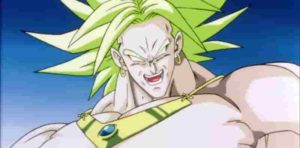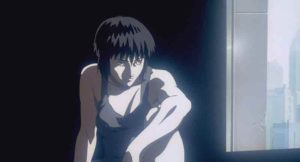The most iconic 90s sci fi anime are:
- Ghost in the Shell
- Mobile Suit Gundam Wing
- Guyver: The Bioboosted Armor
- Cowboy Bebop
- Trigun
- Neon Genesis Evangelion
- Tenchi Muyo!
Ghost in the Shell
Ghost in the Shell is a manga originally created by Masamune Shirow. Then, in 1995 an anime movie was developed, launching several follow up series and a sequel. We follow a cyborg with only a partial human brain, Major Motoko Kusanagi. Motoko’s body is a cutting-edge model owned by the government, which gives our hero a major identity crisis. However, meeting a secretly developed sentient AI system in an investigation flips her concept of self on its head.
This cyberpunk classic takes inspiration from Ridley Scott’s Bladerunner (1982), complete with existential questions about artificial intelligence. However, Ghost in the Shell (1995) takes its own approach to this kind of storytelling and showcases detailed backgrounds and impressive action choreography. The animation, existential story writing and character development make this classic a must watch.
Also, check out Ghost in the Shell: Stand Alone Complex (2002) and the further releases from the franchise.
Mobile Suit Gundam Wing
The 6th installment in the Gundam franchise, Mobile Suit Gundam Wing (1995) introduced an enormous western audience in the 90s to mech anime. Airing on Cartoon Network’s afternoon Toonami segment in the late 90s, Mobile Suit Gundam Wing is a whole generation’s go-to Gundam series.
This addition to the franchise mixes complex ideas with typical anime fun—mechs destroying each other, laser swords, space battles, etc. Five teenagers are chosen to pilot the most advanced and durable mechs called Gundams, striking back against a corrupt United Earth Sphere Alliance. Each elite pilot is given a unique Gundam model, including the memorable Deathscythe and dragon armed Shenlong models. However, the pilots aren’t told about each other before sent on their individual missions.
Naturally, the story plays out with tons of interplanetary politics, conflicts and backstabbing. However, this dialogue and intrigue is mixed with a healthy dose of laser explosions.
Guyver: The Bioboosted Armor
Guyver: The Bioboosted Armor (1989) was a short-lived anime that ran at the begging of the 90s. Based on the Bio Booster Armor Guyver manga by Yoshiki Takaya, the anime covered the first 4 chapters.
Related Posts:
Dragon Ball Z: Why Broly Hates Goku
| Ghost in the Shell: What is a Ghost?
|
The technology explored in this sci fi creature feature revolves around mutation. The Chronos Corporation has secretly engineered workers and soldiers to transform into superhuman monsters called Zoanoids. However, one worker escapes with top secret biosuit weapons that are being studied by The Chronos Corporations. Now, three of these “Guyver units” are on the loose—one of which ends up in the hands of a teenager. Of course.
Now, this Guyver suit has fused with the teenager, Shō Fukamachi, giving him super strength and an arsenal of generated weaponry. Unfortunately, the suit is stuck with Shō. So, the monstrous Zoanoids either seek to turn him to their side or destroy him.
This concept is similar to classic Super Sentai or Ultraman. A team of young adults in super suits fight monsters. However, Guyver takes this concept and makes it R rated. Monsters are supposed to be gory, and this series highlights that fact. We still get the classic teenage superhero we’ve come to enjoy in anime.
Cowboy Bebop
Cowboy Bebop (1998) is a sci fi neo noir by director Shinichirō Watanabe. Appearing in 1998, this genre blending anime became an instant classic among anime fans. Different varieties of jazz and blues influence the feel of the story as we follow the lonely characters on their bounty hunting antics. Also, the show pulls strongly from sci fi, western and noir detective story tropes—sometimes introspective, sometimes full of outer space explosions.
Ex enforcer and legendary gunslinger Spike Spiegel is trying to run from his past, working as a bounty hunter to pay the bills. He partners with ex-cop Jet Black, on board Black’s ship, Bebop. Then, we meet con artist Fay Valentine, who owes a cryogenic company an insane amount in medical bills. Finally, a brilliant girl with advanced hacking ability, along with a genetically engineered corgi, joins the crew. For a moment, the lost characters create a makeshift family.
However, Cowboy Bebop’s existential storytelling won’t allow this small family to live happily ever after. Each person must find their destiny alone and appreciate the friendships along the way. Somehow, the show creators make this concept bittersweet and not just tragic. It’s deep, man!
Trigun
Trigun (1998) is a space western anime that takes place on a planet called No Man’s Land. Originally written and illustrated by Yasuhiro Nightow in 1995, this takes the lone gunslinger archetype and flips it on its head. Ironically, our her is named Vash the Stampede and has a big reputation. However, he is so skilled that he doesn’t have to kill his opponents—and chooses not to.
That’s right, Yasuhiro Nightow created a passivist gunslinger. However, Trigun is pure 90s anime gold. The environment is arid, with a splash of cyber punk within the outlaw culture—especially with the assortment of cybernetic upgrades we see. Vash is bumbling and awkward, completely unassuming. That is, until he gets serious. Then, we’re all left wondering where this crazy character comes from.
The plot revolves two insurance employees who are seeking to stop the damage caused by conflicts with Vash the Stampede. Somehow, even as a passivist, Vash can’t escape this side effect. Along the way, we thread out Vash’s backstory as he encounters various cowboy adventures. This leads to unexpected results, which I won’t spoil here.
Neon Genesis Evangelion
Set in a post-apocalyptic Tokyo-3, Neon Genesis Evangelion (1995) is a mech anime that is known to deconstruct the popular genre. Several teenagers are chosen by the Nerv corporation to pilot giant bio mechs to fight monsters called “Angels”. Our main protagonist Shinji is the son of the leading scientist on the bio mech project, something that causes internal conflict between father and son. Plus, we unravel the mystery of this post-apocalyptic earth and the origin of the Angels.
Often referred to as a deconstruction of the mech genre in anime, Neon Genesis Evangelion follows the inner struggles of its characters. The show explores deep concepts and often uses Shinto, Jewish, and Christian archetypal imagery. However, this deep and emotional storytelling seems to be a hallmark of 90s sci fi anime, elevating the genre overall.
Tenchi Muyo!
Tenchi Muyo! (1992) is an odd bird in this collection, but it sparked a die-hard fanbase in the 90s. Beginning as a 6-episode OVA in 1992 called Tenchi Muyo! Ryo-Ohki, the Tenchi universe expanded into an anime, light novel and manga franchise that can be somewhat confusing to follow. However, once you take a deep dive, this franchise is mind-blowing.
On its face, Tenchi Muyo! is a sci fi harem anime—a genre that surrounds a bumbling male protagonist with beautiful women vying for his attention. In turn, this creates a sense of humor in the way Tenchi is overwhelmed with this affection. This is especially true when the women are inter-dimensional gods of the universe.
However, his story grows into one of intergalactic heroism, as Tenchi reclaims a royal birthright and responsibility of saving the universe. Therefore, what starts out as bumbling guy surrounded by beautiful women ends in meaningful character explorations. Then, we lead into an epic conclusion bigger than the universe itself.


